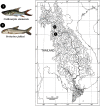Chromosomes of Asian cyprinid fishes: cytogenetic analysis of two representatives of small paleotetraploid tribe Probarbini
- PMID: 30202442
- PMCID: PMC6123905
- DOI: 10.1186/s13039-018-0399-8
Chromosomes of Asian cyprinid fishes: cytogenetic analysis of two representatives of small paleotetraploid tribe Probarbini
Abstract
Background: Polyploidy, although still poorly explored, represents an important evolutionary event in several cyprinid clades. Herein, Catlocarpio siamensis and Probarbus jullieni - representatives of the paleotetraploid tribe Probarbini, were characterized both by conventional and molecular cytogenetic methods.
Results: Alike most other paleotetraploid cyprinids (with 2n = 100), both species studied here shared 2n = 98 but differed in karyotypes: C. siamensis displayed 18m + 34sm + 46st/a; NF = 150, while P. jullieni exhibited 26m + 14sm + 58st/a; NF = 138. Fluorescence in situ hybridization (FISH) with rDNA probes revealed two (5S) and eight (18S) signals in C. siamensis, respectively, and six signals for both probes in P. jullieni. FISH with microsatellite motifs evidenced substantial genomic divergence between both species. The almost doubled size of the chromosome pairs #1 in C. siamensis and #14 in P. jullieni compared to the rest of corresponding karyotypes indicated chromosomal fusions.
Conclusion: Based on our findings, together with likely the same reduced 2n = 98 karyotypes in the remainder Probarbini species, we hypothesize that the karyotype 2n = 98 might represent a derived character, shared by all members of the Probarbini clade. Besides, we also witnessed considerable changes in the amount and distribution of certain repetitive DNA classes, suggesting complex post-polyploidization processes in this small paleotetraploid tribe.
Keywords: Chromosomal markers; Cyprinidae; Fish cytogenetics; Microsatellites; rDNAs.
Conflict of interest statement
Experiments were performed in accordance with ethical protocols, and anesthesia using clove oil was administered prior to sacrificing the animals, as approved by the Ethics Committee of Khon Kaen University and by the RGJ committee under no. PHD/K0081/2556.Not applicableThe authors declare that they have no competing interests.Springer Nature remains neutral with regard to jurisdictional claims in published maps and institutional affiliations.
Figures



Similar articles
-
Chromosomes of Asian Cyprinid Fishes: Genomic Differences in Conserved Karyotypes of 'Poropuntiinae' (Teleostei, Cyprinidae).Animals (Basel). 2023 Apr 20;13(8):1415. doi: 10.3390/ani13081415. Animals (Basel). 2023. PMID: 37106978 Free PMC article.
-
Chromosomes of Asian cyprinid fishes: Novel insight into the chromosomal evolution of Labeoninae (Teleostei, Cyprinidae).PLoS One. 2024 Feb 7;19(2):e0292689. doi: 10.1371/journal.pone.0292689. eCollection 2024. PLoS One. 2024. PMID: 38324533 Free PMC article.
-
Microsatellite repeat mapping shows inner chromosomal diversification in highly conserved karyotypes of Asian cyprinid fishes.Comp Cytogenet. 2025 Mar 31;19:29-50. doi: 10.3897/compcytogen.19.141557. eCollection 2025. Comp Cytogenet. 2025. PMID: 40201068 Free PMC article.
-
A comparative cytogenetic study of Hypsibarbusmalcolmi and H.wetmorei (Cyprinidae, Poropuntiini).Comp Cytogenet. 2023 Sep 15;17:181-194. doi: 10.3897/compcytogen.17.107703. eCollection 2023. Comp Cytogenet. 2023. PMID: 37794860 Free PMC article.
-
Karyotype diversity and evolutionary trends in the Asian swamp eel Monopterus albus (Synbranchiformes, Synbranchidae): a case of chromosomal speciation?BMC Evol Biol. 2019 Mar 8;19(1):73. doi: 10.1186/s12862-019-1393-4. BMC Evol Biol. 2019. PMID: 30849933 Free PMC article.
Cited by
-
Taxonomic Diversity Not Associated with Gross Karyotype Differentiation: The Case of Bighead Carps, Genus Hypophthalmichthys (Teleostei, Cypriniformes, Xenocyprididae).Genes (Basel). 2020 Apr 28;11(5):479. doi: 10.3390/genes11050479. Genes (Basel). 2020. PMID: 32354012 Free PMC article.
-
Chromosomes of Asian Cyprinid Fishes: Genomic Differences in Conserved Karyotypes of 'Poropuntiinae' (Teleostei, Cyprinidae).Animals (Basel). 2023 Apr 20;13(8):1415. doi: 10.3390/ani13081415. Animals (Basel). 2023. PMID: 37106978 Free PMC article.
References
-
- Braasch I, Postlethwait JH. Polyploidy in fish and the teleost genome duplication. In: Soltis PS, Soltis DE, editors. Polyploidy and genome evolution. Berlin: Springer; 2012. pp. 341–383.
LinkOut - more resources
Full Text Sources
Other Literature Sources

